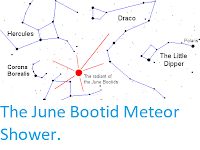Asteroid 532 Herculina will reach opposition (the point at which it is
directly opposite the Sun when observed from the Earth) at 7.10 am GMT
on Friday 3 July 2020, when it will also be at the closest point on
its orbit to the Earth, 1.729 AU (i.e. 1.729 times as far from the
Earth as the Sun, or about 258 655 000 km), and be completely
illuminated by the Sun. While it is not obvious to
the naked eye observer, asteroids have phases just like those of the
Moon; being further from the Sun than the Earth, 532 Herculina is 'full'
when
directly opposite the Sun. As 532 Herculina is only about 225 km in
diameter, it will not be visible to the naked eye, but with a maximum
Apparent Magnitude (luminosity) of 9.5 at opposition, it should be
visible in the Constellation of Sagittarius to viewers equipped with a good pair
of binoculars or small telescope.
The position of 532 Herculina at opposition. Heavens Above.
532 Herculina was discovered on 20 April 1904 by the German astronomer
Max Wolf, as originally given the designation 1904 NY, which implies
that it was discovered in 1904 and was the 324th asteroid (asteroid NY)
discovered after the introduction of a double-lettered designation
system introduced in January 1893 (in which AA equalled 1, AB equalled
2, BA equalled 25 etc.). It was later named 'Herculina' by Wolf and
given the designation 532, for the 532nd asteroid ever discovered.
The orbit of 532 Herculina, and its position at opposition in 2020. JPL Small Body Database.
532 Herculina
has an 1686 day orbital period and an eccentric orbit
tilted at an angle of 16.3° to the plane of the Solar System, which
takes it from 2.28 AU from the Sun (i.e. 228% of the the average
distance at
which the Earth orbits the Sun) to 3.26 AU from the Sun (i.e. 326% of
the
average distance at which the Earth orbits the Sun). As an asteroid that
never comes within 1.666 AU of the Sun and has an average orbital
distance less than 3.2 AU from the Sun, 532 Herculina is classed as a
Main Belt Asteroid.
See also...
Follow Sciency Thoughts on Facebook.








